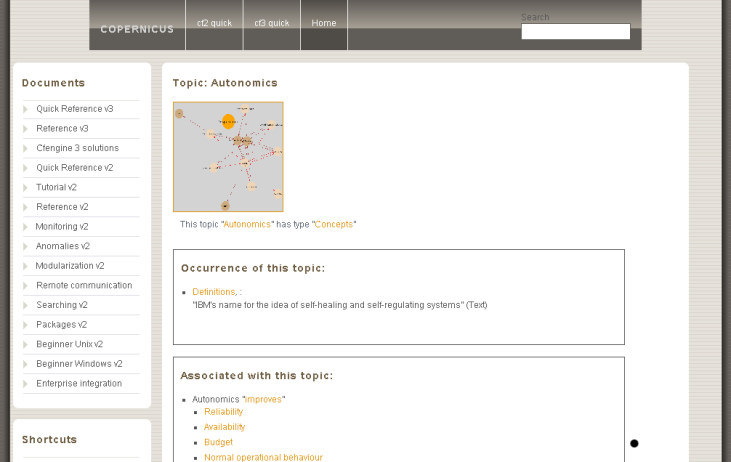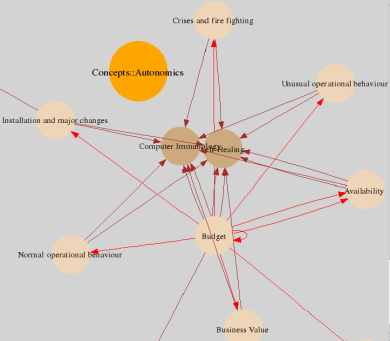
Copernicus is CFEngine's knowledge integration tool, proving
semantically linked access to our extended documentation for support
customers. Copernicus is really just CFEngine 3 in disguise. The
website is powered by CFEngine 3's knowledge agent cf-know. Only
the content is proprietary – and even then we encourage you to
help develop it by sending us suggestions for improvement.
Copernicus was made famous for his heliocentric view of the universe, placing the sun at the centre and seeing the planets orbit around it.

CFEngine's Copernicus is a simplified implentation of ISO standard Topic Maps, in which every page is based around a topic. It places a given topic of interest in the centre of focus and shows what other concepts are closely related to it. Just click on a concept to see how it relates to nearby concepts and to find references to the documentation.
The best way to use the topic map is simply to explore for a while and use the search field to short-cut to relevant topics.
A topic is any subject that we want to talk about or represent.
Strictly speaking, the term <i>topic</i> refers to the object or node in the topic map that represents the subject being referred to. However, there is a one-to-one relationship between topics and subjects, with every topic representing a single subject and every subject being represented by just one topic. To a certain degree, therefore, the two terms can be used interchangeably

Topics can be categorized according to their type. In a topic map, any given topic is an instance of zero or more topic types. This corresponds to the categorization inherent in the use of multiple indexes in a book (index of names, index of works, index of places, etc.).
Types are used mainly to disambiguate topics of the same namin different contexts.
An association is a semantic relationship between two topics. The associative distance between topics is what defines the solar system of a topic in Copernicus. Associations are what links ideas together in the knowledge base, e.g.
is implemented by
is an example of
is an aspect/component of
was a feature added in
An occurrence of a topic is a piece of information about it. This is normally the reason for using the topic map in the first place – to arrive at an actual document, or occurrence of the topic. In CFEngine occurrences can be short literal explanations, or the can be red URL pointers to documentation.
An occurrence pointer will lead you some some text that says something about the topic.
The search field at the top right hand corner of the header may be used to enter Perl Compatible Regular Expressions to match topic name fragments. Searches are case insensitive. Do not enter more than one keyword at a time, the expression should match only a single name, e.g.
web
web server
web.*module.*
apache
Copernicus provides some graphical representations of topic space, showing approximately 30 of the closest related topics. This magic number 30 is one of the Dunbar numbers and represents the number of working relationships humans can typically maintain.

The graphics are not a complete represenation of the topic map but are designed to provoke associative thought. You can reach all of the links by going to the Associations section of a topic page (assuming there are associations).
The graphical aspects of copernicus are being developed as part of our research into knowledge management. Users can expect future improvements to the analysis and navigation features.
Entering the expert knowledge in Copernicus is a huge and time-consuming task. Help us to improve the knowledge base by sending us your wishes and suggestions. Every `stupid question' and smart lateral thought that you send us can help someone to find what they need more quickly.
We are constantly researching and analysing the data we have and the patterns of usage we observe. All of this will lead to a more sophisticated experience in the coming years.